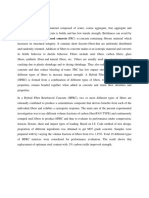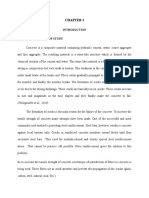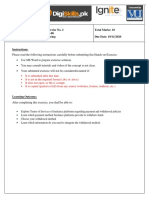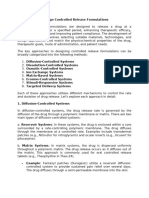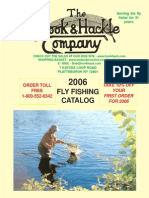Project Report
Uploaded by
Malik ZainProject Report
Uploaded by
Malik ZainAbstract
Concrete is one of the most widely used construction material since the early 1800’s. It has
been known that the concrete is week in tension and strong in compression. Weak tensile
strength combined with brittle behavior result in the sudden tensile failure without warning
that is obviously not desirable for any construction material. Thus, concrete required some
form of tensile reinforcement to compensate its brittle behavior, improve tensile strength and
strain capacity to be used in any construction. Historically steel is used for tensile
reinforcement in concrete. Unlike reinforcement bar are specifically designed and placed in
tensile zone of concrete member.
Worldwide, a great deal of research is currently been conducted concerning the use of fiber in
concrete as an alternative for steel. Fiber are considered to be a promising alternative to steel
reinforcement, especially in concrete structure. Unlike steel, Fibers are thin short and
distributed randomly throughout the concrete member. Fibers are commercially available and
manufactured from steel, plastic (monofilament), glass and other natural material (e.g., Straw,
horse hairs, coconut coir’s). Fiber Reinforced concrete, FRC is a concrete mix which utilize
fibrous material as a reinforcement. These Randomly Oriented, uniformly distributed fiber
exhibit a variety of properties when mixed with concrete. Fiber reinforced concrete give
different Tensile, Flexural and Compression properties of concrete as compared to PCC and
RCC. The Report show the tensile, flexural and compressive properties of Steel and
Polypropylene Fiber concrete as compared to Plain Reinforced concrete.
Steel fibers are discrete, short length of steel having ratio of its length to diameter with any of
the several cross-sections and that are sufficiently small to be easily and randomly dispersed
in fresh concrete mix using conventional mixing procedure. Steel fibers improve durability to
control cracking and lower deflection. Polypropylene is a thermoplastic polymer utilized as a
part of wide assortment of use. Polypropylene fibers in concrete mix design used for multiple
purpose that includes rigid pavement, self-compacting concrete and other applications.
Polypropylene increase the water tightness that reduce crack.
After carefully testing the material required for concrete, we moved to comparison between
FRC and PCC. This is a preliminary step required to set a base to decide whether we use PCC
or FRC by comparison of their different properties e.g., Tensile, Flexural and Compressive
Strength of Fiber reinforced concrete with Plain Reinforced Concrete.
This Document provides guidelines on how Fiber may be used in concrete, although further
research is required in this field to understand the effect of these fibers in detail. This
document will provide preliminary step in how to use Fiber in simple PCC concrete and what
will be come in comparison with the outcome of the Fiber Reinforced Concrete, FRC with
Plain Reinforced Concrete, PCC.
You might also like
- Important World Wide Production TonnageNo ratings yetImportant World Wide Production Tonnage37 pages
- Seminar Report On Fiber Rainforced Concrete91% (11)Seminar Report On Fiber Rainforced Concrete48 pages
- Fibre Reinforced CONCRETE - PPTX: Historical DevelopmentNo ratings yetFibre Reinforced CONCRETE - PPTX: Historical Development14 pages
- Fibre Reinforced Concrete FRC Ijariie4483No ratings yetFibre Reinforced Concrete FRC Ijariie44837 pages
- Reference 101. Effect of Fibers in Concrete CompositesNo ratings yetReference 101. Effect of Fibers in Concrete Composites13 pages
- Aijaz Report Advanced Buiding MaterialsNo ratings yetAijaz Report Advanced Buiding Materials14 pages
- Literature Review Fiber Reinforced Concrete100% (2)Literature Review Fiber Reinforced Concrete5 pages
- An Investigation On Design Procedure and Operations of Polymer Fibre Reinforced Concrete Pavements by S. Panda & N.H.S.rayNo ratings yetAn Investigation On Design Procedure and Operations of Polymer Fibre Reinforced Concrete Pavements by S. Panda & N.H.S.ray12 pages
- Theory and Applications of Fibre Reinforced Concrete (FRC)No ratings yetTheory and Applications of Fibre Reinforced Concrete (FRC)16 pages
- Glass Fiber Reinforced Concrete: Mahavir Swami College of PolytechnicNo ratings yetGlass Fiber Reinforced Concrete: Mahavir Swami College of Polytechnic59 pages
- Fibre Reinforced Concrete: A Consise ReportNo ratings yetFibre Reinforced Concrete: A Consise Report5 pages
- Steel Fibre Concrete Composites For Special Applications100% (3)Steel Fibre Concrete Composites For Special Applications213 pages
- Fiber-Reinforced Concrete - Advantages, Types and ApplicationsNo ratings yetFiber-Reinforced Concrete - Advantages, Types and Applications8 pages
- A Review Study On Effect of Steel Fibre and Marble Dust With Strength of Pavement Quality ConcreteNo ratings yetA Review Study On Effect of Steel Fibre and Marble Dust With Strength of Pavement Quality Concrete4 pages
- steelfibrereinforcedconcrete-170404092039No ratings yetsteelfibrereinforcedconcrete-17040409203926 pages
- Effect of Steel Fibers On Strength of ConcreteNo ratings yetEffect of Steel Fibers On Strength of Concrete8 pages
- Steel Fiber Reinforced Concrete A Review PDFNo ratings yetSteel Fiber Reinforced Concrete A Review PDF12 pages
- Properties of Fibre Reinforced Concrete-A Comparative Studies of Steel Fibre and Poly-FibreNo ratings yetProperties of Fibre Reinforced Concrete-A Comparative Studies of Steel Fibre and Poly-Fibre5 pages
- Flexural Behavior of Steel Fiber Reinforced Concrete Beams: Hamid Pesaran BehbahaniNo ratings yetFlexural Behavior of Steel Fiber Reinforced Concrete Beams: Hamid Pesaran Behbahani18 pages
- Case Study Preparing The Proper Ethical and Legal FoundationNo ratings yetCase Study Preparing The Proper Ethical and Legal Foundation6 pages
- Case Study Industry and Competitor AnalysisNo ratings yetCase Study Industry and Competitor Analysis4 pages
- Case Study Developing An Effective Business ModelNo ratings yetCase Study Developing An Effective Business Model8 pages
- Hands-On Exercise No. 4 Batch-08 Freelancing Total Marks: 10No ratings yetHands-On Exercise No. 4 Batch-08 Freelancing Total Marks: 104 pages
- Hands-On Exercise No. 2 Batch-08 Freelancing Total Marks: 10No ratings yetHands-On Exercise No. 2 Batch-08 Freelancing Total Marks: 104 pages
- Hands-On Exercise No. 2 Batch-08 Autocad Total Marks: 10 Due Date: 19/11/2020No ratings yetHands-On Exercise No. 2 Batch-08 Autocad Total Marks: 10 Due Date: 19/11/20203 pages
- Hands-On Exercise No. 3 Batch-08 Freelancing Total Marks: 10No ratings yetHands-On Exercise No. 3 Batch-08 Freelancing Total Marks: 104 pages
- Hands-On Exercise No. 1 Batch-08 Freelancing Total Marks: 10No ratings yetHands-On Exercise No. 1 Batch-08 Freelancing Total Marks: 104 pages
- Hands-On Exercise No. 4 Batch-08 Freelancing Total Marks: 10 Due Date: 17/12/2020No ratings yetHands-On Exercise No. 4 Batch-08 Freelancing Total Marks: 10 Due Date: 17/12/20203 pages
- Hands-On Exercise No. 2 Batch-08 Freelancing Total Marks: 10 Due Date: 19/11/2020No ratings yetHands-On Exercise No. 2 Batch-08 Freelancing Total Marks: 10 Due Date: 19/11/20203 pages
- Composite Materials: Design, Analysis & ApplicationsNo ratings yetComposite Materials: Design, Analysis & Applications10 pages
- Mini Test # 67 - Endomembrane System & Endoplasmic ReticulumNo ratings yetMini Test # 67 - Endomembrane System & Endoplasmic Reticulum4 pages
- Exercise 5 Impregnation and Embedding: Name: Dayagan, Gwyneth Marie M. Date: JULY 8, 2021No ratings yetExercise 5 Impregnation and Embedding: Name: Dayagan, Gwyneth Marie M. Date: JULY 8, 20218 pages
- PASSAGE 2 A unique golden textile ExplanationsNo ratings yetPASSAGE 2 A unique golden textile Explanations2 pages
- Firefighters' Clothing and Equipment Performance, Protection, and ComfortNo ratings yetFirefighters' Clothing and Equipment Performance, Protection, and Comfort372 pages
- Taheebo (Tabebuia Avellanedae) Leaves Extract As Fabric DyeNo ratings yetTaheebo (Tabebuia Avellanedae) Leaves Extract As Fabric Dye19 pages
- Cross-Linking in Hydrogels - A Review: 2. Significance of CrosslinkingNo ratings yetCross-Linking in Hydrogels - A Review: 2. Significance of Crosslinking7 pages
- Amare Catalogue Winter 2022 - v2.7-LR-compressedNo ratings yetAmare Catalogue Winter 2022 - v2.7-LR-compressed32 pages
- Luis Pinacho-Rios Activity 4c Dye ElectrophoresisNo ratings yetLuis Pinacho-Rios Activity 4c Dye Electrophoresis4 pages
- Investigatory - Project - Chemistry - 11th (1) 2No ratings yetInvestigatory - Project - Chemistry - 11th (1) 214 pages
- Removal and Recovery of Levafix Brilliant Red E-4BA and Levafix Brilliant Red E-6BA From Aqueous Solution by Membrane TechniqueNo ratings yetRemoval and Recovery of Levafix Brilliant Red E-4BA and Levafix Brilliant Red E-6BA From Aqueous Solution by Membrane Technique7 pages


